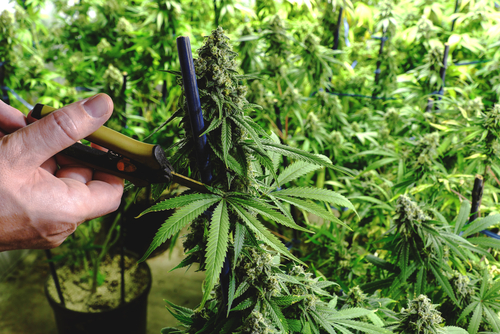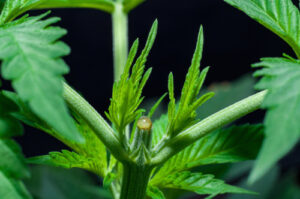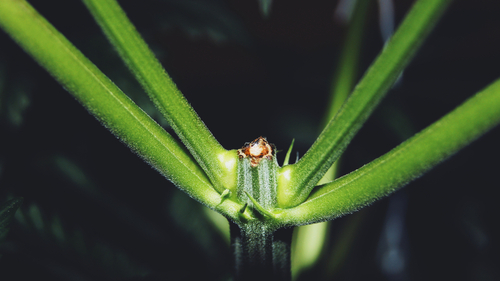Pruning may seem like an unnecessary and time-consuming technique for growing cannabis. Unlike light, a growing medium, and water, marijuana strains don’t need regular pruning sessions. As long as you carefully keep tabs on your plants, unpruned cannabis hybrids should produce yields.
However, those who start pruning cannabis often never look back. Why? In most cases, pruning techniques have a positive impact on cannabis yields. If you put a pruning strategy into place, there’s a good chance you could dramatically increase your harvests. Adding pruning to your indoor gardening routine can significantly impact your cannabis cultivation experience.
What’s The Point Of Pruning Cannabis?

The key point behind pruning cannabis is to maximize your plant’s efficiency. A well-pruned cannabis strain won’t have to expend as much energy on leaves, branches, or tiny buds. Removing useless plant material will help your cannabis plant put all of its effort towards creating fat & healthy bud sites.
Pruning fan leaves also helps improve air circulation and light penetration in your weed strains. This increases the number of potential bud sites and reduces the threat of mold, pests, and other infestations. There are fewer sites in a pruned cannabis plant for invaders to attach to, even if your indoor environment has above-average humidity. All of these factors improve the odds you’ll have a healthy and bountiful harvest at the end of the flowering stage.
How Do People Prune Marijuana Plants? — A Few Strategies To Consider
There’s no singular “pruning” technique in cannabis. In fact, there are many ways you could add pruning to your schedule. Choosing the “right” pruning strategy depends on many personal factors, including your gardening skill, comfort level, and the strain you’re growing. Carefully consider each pruning method when determining how to add this technique to your grow room.
Topping: A High-Profile High-Stress Pruning Technique
Arguably, topping is the most well-documented pruning strategy in cannabis cultivation. Also known as “pinching,” this technique involves cutting off the “top” portion of the plant’s main stem.
The goal behind this strategy is to encourage two new bud sites to emerge under where the main cola would have been. Therefore, when your plant reaches full flowering, it will have two large colas rather than one. Not only does this double your yield at the top of your plant, it helps reduce your cannabis plant’s height. The lateral growth associated with topped plants will reduce your space requirements and encourage more light to reach buds lower on your plant.

Most cannabis cultivators recommend waiting until your vegetative plant has about five nodes before topping it. You must also ensure your weed shows zero signs of disease or weakness. Topping is considered a “high-stress” technique, so it will take time for cannabis plants to recover. Only healthy plants can withstand the shock of a topping procedure.
When topping a cannabis plant, make a quick and clean cut just above the next node below the top cola. You should see two tiny “axillary buds” on the sides of the node site. These small bud sites will become the central colas after your plant recovers from topping.
Please be sure to sanitize your pruning shears before cutting your cannabis plant. Also, only use shears that you know are sharp. You should consider topping a form of extreme “cannabis surgery.” If you use unsanitized or dull shears, you will increase the risk of transmitting an infection to your plant.
While you could stop topping your plant with this first cut, some cultivators snip the two new colas as they mature. When done correctly, this could lead to four main cola sites and even more significant lateral growth. However, please remember that topping is incredibly stressful for cannabis plants. Only perform a second topping procedure if your plants are healthy enough.
FIMming: A Fascinating Variation On Topping
In cannabis cultivation, the acronym “FIM” means “f*ck I missed,” and it refers to a slight variation on the topping technique. Apparently, cannabis growers accidentally cut their vegetative plant further above the next node than they “should” have.

Although this was a mistake from the classic topping perspective, it yielded good results for growers. In fact, some cultivators argue that FIMming cannabis plants is less stressful than topping. Since you’re only taking away about ¾ of the plant’s top, it’s not as invasive. Also, there’s a chance FIMming cannabis plants could result in four main colas rather than two.
A potential disadvantage of FIMming compared with topping is that the former doesn’t significantly reduce height growth. If you’re in a small grow room, you may need to employ other training techniques like bending if you want to use FIMming as your pruning method.
Look Into Lollipopping
Lollipopping is a significantly different pruning technique compared with topping and FIMming. Unlike the previous two methods, lollipopping involves cutting buds and branches at the bottom of your plant. Since all of the leaves and buds on this plant are on the top, it looks like a “lollipop.”
Every cultivator has a unique strategy for lollipopping, but most recommend using this procedure in late vegetation or early flowering. You should concentrate on cutting tiny bud sites on the bottom 40% of your plant. Some people cut away all of the branches and fan leaves in these low areas, but it’s not necessary to go that extreme. Please remember that fan leaves play a crucial role in light absorption, so cutting these fan leaves isn’t beneficial.
Although lollipopping has many fans in the cannabis community, there are questions regarding its efficacy in improving yields. Some argue that the total harvests in some lollipopped plants aren’t statistically greater than non-lollipopped strains. To gauge how effective lollipopping is, you should experiment with one strain and compare it with a non-lollipopped variety in your grow room. This test will help you determine how much this technique affects different cannabis varieties.
Develop A “Prune As You Go” Approach
If you don’t want to use a standard pruning technique, you could simply get into the habit of manicuring cannabis plants throughout vegetation and flowering. Always focus on removing leaves or bud sites showing signs of weakness, mold, or infestation. Some cultivators also recommend pruning branches in the middle of your plant to help improve air circulation.
There’s no standard technique for pruning cannabis using this strategy. Instead, you will have to gauge your plant’s health and make decisions based on your strain’s growth pattern. In these cases, it’s best to consult cannabis growing forums to see how other cultivators manage the same strain.
You can learn more about distinguishing healthy and unhealthy fan leaves in our guide to “Yellow Cannabis Leaves.”
When Is The Best Time To Prune Cannabis?
Most cannabis pruning techniques start during the vegetative stage. This is especially true with high-stress techniques like FIMming and topping. In these cases, you need your cannabis strain to be strong enough to withstand the strong impact of these strategies.
While you can usually start pruning during vegetation, many cultivators carry their pruning strategy into flowering. Indeed, lollipopping is typically performed early in the flowering stage. Basically, whenever you see plant growth that’s diseased or has little potential for significant bud production, you could use pruning on your plants.
Can You Prune Autoflower Cannabis?
It’s possible to prune autoflower cannabis strains, but most cultivators advise against it. Unlike photoperiod weed, autoflowers will flower without a switch in your light schedule. Therefore, you can’t manually keep your autoflower strain in vegetation to allow it to recover.
Since topping and FIMming involve a lot of plant stress, you must ensure your plant recovers before moving on to flowering. However, an autoflower plant will transition to flowering even if it doesn’t fully recover from these pruning techniques.
Instead of pruning autoflowers with high-stress techniques, most people use low-stress training like bending or Screen of Green (ScrOG) on these plants. Since these methods aren’t too stressful, there’s a greater chance autoflower strains will thrive and produce greater yields.
For more information on how to grow autoflower strains, please read this previous International High Life guide.
Is It Bad To Avoid Pruning Cannabis?
It’s not “wrong” to avoid pruning cannabis plants, but neglecting to prune your strains can have negative consequences. Most notably, plants that aren’t pruned tend to have a higher risk for mold, fungal infections, and pests. The more plant matter there is, the more opportunities pathogens have to land on your strains. Plus, more fan leaves create blockages, which is terrible for air circulation.
But it’s not just plant hygiene that makes pruning a valuable technique. Cannabis plants will naturally grow vertically with only one main cola. Cultivators colloquially refer to this as the “Christmas tree” pattern. Since this central cola absorbs most of the light, it’s not the most efficient use of a grow space. Also, many at-home growers may not have enough vertical room to support an unpruned & untrained cannabis plant. Lastly, since the size of one central cola is so large, plants may have difficulty supporting themselves and start to bend during flowering.
Again, it’s possible to grow healthy cannabis plants without using pruning. However, there are a few drawbacks to consider if you avoid adding pruning to your routine.
Combine Pruning With Training For Superior Cannabis
There’s a lot of cross-over between training and pruning cannabis plants. In fact, some techniques like topping and FIMming are technically “training” strategies.
Cultivators who want to make the most of their marijuana garden should consider whether using training would yield greater results. For instance, many people combine ScrOG with lollipopping, while others may use both topping and LST bending. The more you learn about combining pruning and training techniques, the better use you’ll make of your cannabis grow space.

Leave a Reply